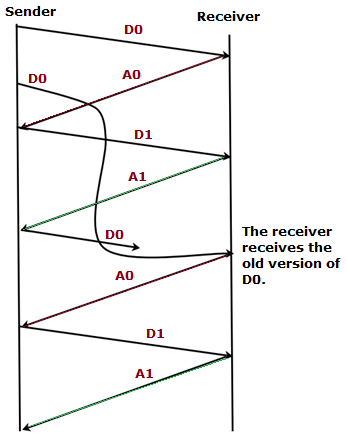
 Question
Question
Consider the rdt 3.0 protocol. Draw a diagram showing that if the net-work connection between the sender and receiver can reorder messages (that is, that two messages propagating in the medium between the sender and receiver can be reordered), then the alternating-bit protocol will not work correctly (make sure you clearly identify the sense in which it will not work correctly). Your diagram should have the sender on the left and the receiver on the right, with the time axis running down the page, showing data (D) and acknowledgment (A) message exchange. Make sure you indicate the sequence number associated with any data or acknowledgment segment.
 Answer
Answer
rdt 3.0 protocol’s message exchange procedure:
rdt 3.0 stands for reliable data transfer protocol. The following are the steps involved in message exchange.
The following diagram represents the sender and receiver connected through a network. The messages reordering is illustrated:

In the above diagram D0, D1 indicate data with sequence number 0 and 1 respectively. A0, A1, indicates acknowledgements with sequence number 0 and 1 respectively.
Step by step process of message exchange:
- The sender sends the data D0 to the receiver expects an acknowledgment from receiver. So, the sender waits for the acknowledgment for a specific period of time.
- Since the sender does not received the acknowledgement from the receiver, it assumes that the data D0 is not received by the receiver. So, the sender sends D0 again.
- After sending the data D0 for the second time, the sender receives the acknowledgement A0 from the receiver, it sends the data D1.
- The receiver receives the data D1 and sends the acknowledgement A1 to the sender.
- The receiver receives the retransmitted data D0 and sends the acknowledgement A0 again to the sender assuming that the previous acknowledgement is not received by the sender. So, the old version of data D0 is acknowledged by the receiver.
- The sender repeats the data D1 transmission and the receiver sends the acknowledgement A1 to the sender.
The new version of the data D0 received by the receiver is replaced by the old version of the data D0 due to the reordering.
Therefore, the protocol is not working well and message exchange is improper. Data is not transmitted as intended.















